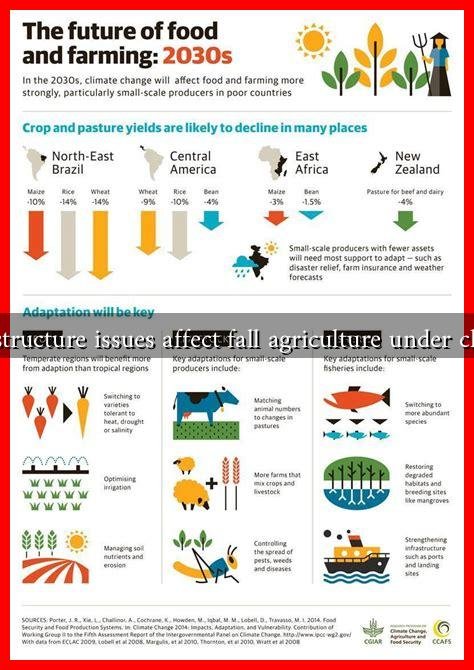-
Table of Contents
How Do Infrastructure Issues Affect Fall Agriculture Under Climate Change?
As climate change continues to reshape weather patterns and environmental conditions, the agricultural sector faces unprecedented challenges. Fall agriculture, in particular, is significantly impacted by infrastructure issues exacerbated by climate change. This article explores how these infrastructure challenges affect fall agriculture, highlighting the importance of resilient systems to ensure food security and sustainability.
The Interplay Between Climate Change and Agriculture
Climate change has led to increased temperatures, altered precipitation patterns, and more frequent extreme weather events. These changes directly affect agricultural productivity, especially during the fall harvest season. Farmers rely on a robust infrastructure to manage these challenges effectively. However, many regions face aging or inadequate infrastructure that can hinder agricultural resilience.
Key Infrastructure Issues Affecting Fall Agriculture
Several infrastructure-related challenges can significantly impact fall agriculture:
- Transportation Networks: Poorly maintained roads and bridges can delay the transportation of crops to markets, leading to spoilage and financial losses.
- Irrigation Systems: Inadequate irrigation infrastructure can exacerbate drought conditions, making it difficult for farmers to maintain crop yields during critical growth periods.
- Storage Facilities: Insufficient or outdated storage facilities can lead to post-harvest losses, particularly in regions experiencing extreme weather events.
- Energy Supply: Unreliable energy sources can disrupt operations, affecting everything from irrigation to processing and transportation.
Case Studies: Real-World Impacts
Several case studies illustrate the profound effects of infrastructure issues on fall agriculture under climate change:
- California Droughts: In California, prolonged droughts have strained irrigation systems, leading to reduced yields for fall crops like grapes and almonds. Farmers have reported losses of up to 30% due to inadequate water supply.
- Hurricane Damage in the Southeast: The 2017 hurricane season devastated many agricultural regions in the Southeastern United States. Flooding damaged roads and storage facilities, resulting in significant crop losses and delayed harvests.
- Midwest Flooding: In 2019, heavy rains and flooding in the Midwest disrupted the fall harvest of corn and soybeans. Farmers faced logistical challenges in transporting their crops, leading to a 20% decrease in overall yield.
Statistics Highlighting the Impact
Statistics underscore the urgency of addressing infrastructure issues in the context of climate change:
- According to the USDA, approximately 30% of U.S. agricultural production is affected by inadequate infrastructure.
- A report from the National Oceanic and Atmospheric Administration (NOAA) indicates that extreme weather events have increased by 40% over the past decade, directly impacting agricultural output.
- The World Bank estimates that improving rural infrastructure could increase agricultural productivity by up to 25% in developing countries.
Strategies for Improvement
To mitigate the effects of infrastructure issues on fall agriculture under climate change, several strategies can be implemented:
- Investment in Modern Infrastructure: Governments and private sectors should invest in upgrading transportation, irrigation, and storage facilities to withstand climate-related challenges.
- Adoption of Technology: Utilizing precision agriculture technologies can help optimize resource use and improve crop resilience.
- Community Engagement: Involving local farmers in infrastructure planning can ensure that their needs are met and that solutions are tailored to specific challenges.
Conclusion
Infrastructure issues play a critical role in shaping the future of fall agriculture, especially in the face of climate change. As weather patterns become increasingly unpredictable, the need for resilient infrastructure becomes more pressing. By addressing these challenges through investment, technology, and community engagement, we can enhance agricultural productivity and ensure food security for future generations. The time to act is now, as the impacts of climate change will only intensify without proactive measures.
For more information on how climate change affects agriculture, visit the USDA Natural Resources Conservation Service.

